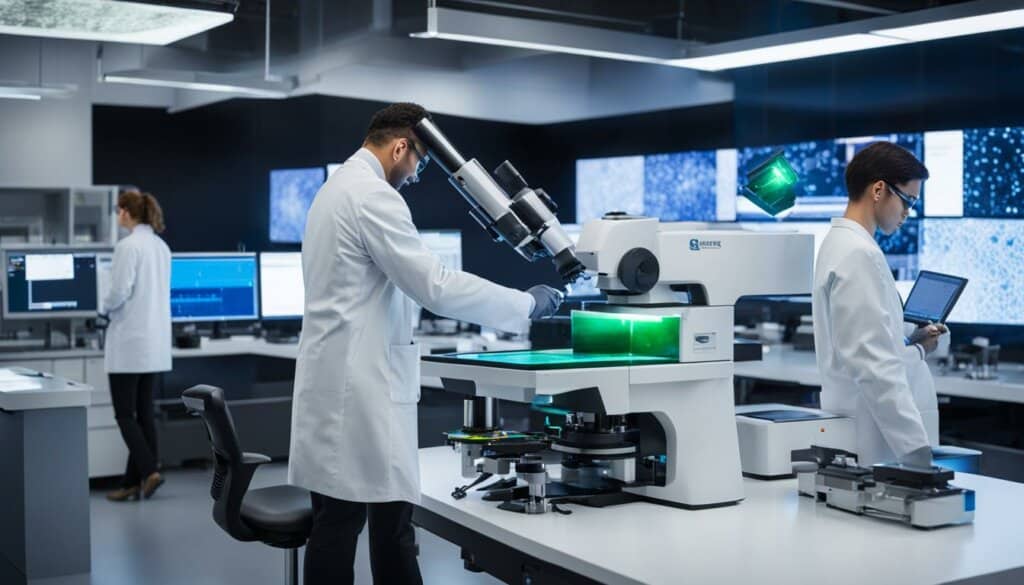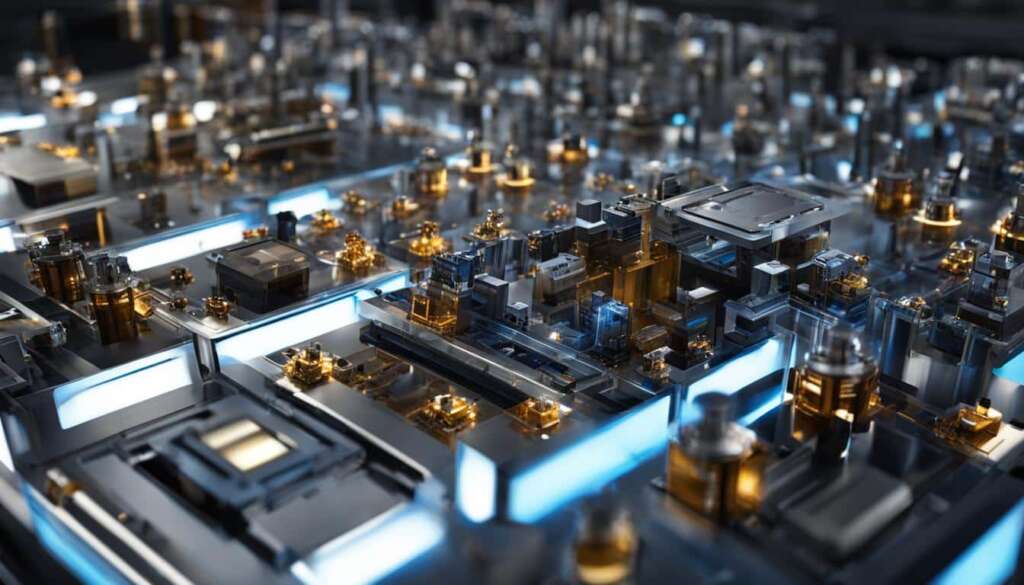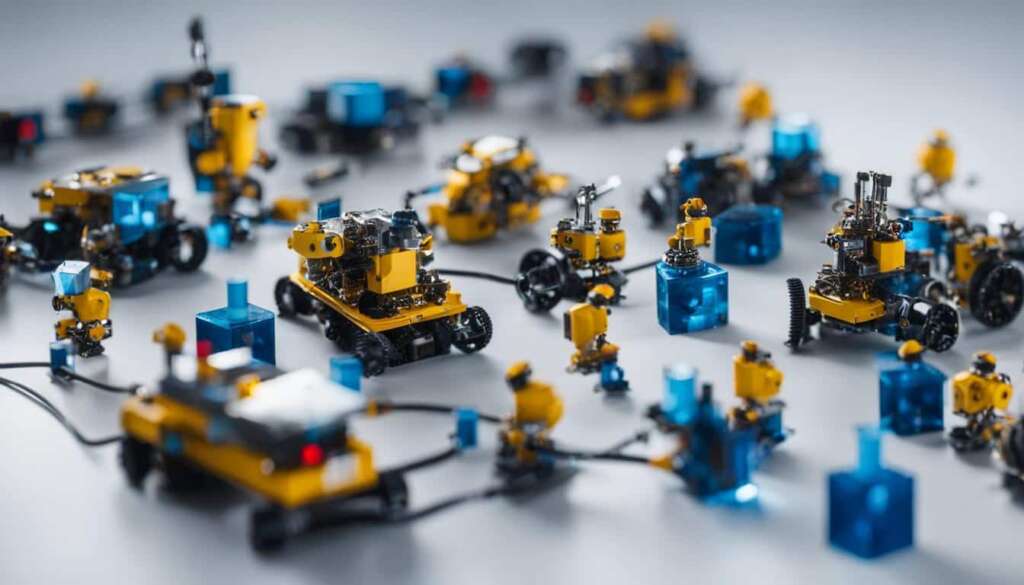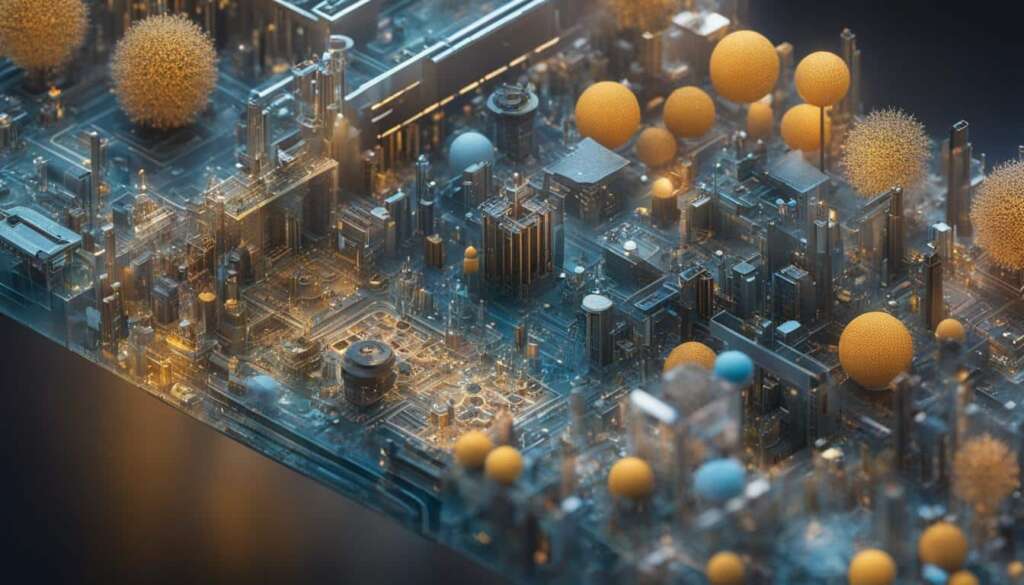Table of Contents
Nanotechnology, the control of matter on a molecular scale, is a transformative technology that is shaping the future. By understanding and harnessing the power of nanotechnology, we can unlock a world of possibilities and create innovative solutions to various challenges.
From healthcare to electronics, nanotechnology has already found its way into numerous everyday products, revolutionizing industries and improving our lives in unexpected ways. In this article, we will delve into the fascinating field of nanotechnology and explore the diverse applications that make use of this groundbreaking science.
Key Takeaways:
- Nanotechnology is a transformative technology that is shaping the future.
- It involves manipulating matter at the atomic and molecular level.
- Nanoparticles provide enhanced properties such as increased strength and electrical conductivity.
- Nanotechnology finds applications in various industries, including medicine, materials science, and electronics.
- Nanotech holds immense potential for future innovations and advancements.
What is Nanotechnology?
Nanotechnology involves manipulating matter at the atomic and molecular level. It allows us to see and control atoms, creating new materials and products. The scale of nanotechnology is incredibly small, with measurements in nanometers. Understanding the nanoscopic world can lead to the development of super-strong materials and innovative solutions.
At the heart of nanotechnology lies the ability to construct and manipulate materials at a tiny scale. By working with particles and structures that are only a few nanometers in size, scientists and engineers can harness unique properties and tailor materials to specific needs. This level of control has far-reaching implications across various industries, from medicine to electronics and beyond.
The Atomic and Molecular Level
One of the distinguishing features of nanotechnology is its focus on the atomic and molecular level. Rather than working with bulk materials, scientists zoom in to the tiniest particles that make up matter. At this scale, properties and behaviors differ from those at larger scales, leading to new possibilities and applications.
Construction on a Tiny Scale
Nanotechnology involves the construction of structures, devices, and materials on a tiny scale. By manipulating atoms and molecules, scientists can assemble materials with precise properties and functionalities. This opens up a world of possibilities for engineering new materials with enhanced characteristics, including improved strength, conductivity, and reactivity.
“Nanotechnology offers unprecedented control over matter, enabling us to engineer materials with unique properties and functionalities.” – Professor James Smith, Nanotechnology Researcher
Everyday Products that Use Nanotechnology
Many everyday products already make use of nanotechnology. Nanotechnology, with its ability to manipulate matter at the atomic and molecular level, has paved the way for innovative solutions in various industries. Let’s explore some common products that harness the power of nanotechnology:
Sunscreens
Sunscreens are an essential part of our daily lives, protecting our skin from harmful UV radiation. Nanoparticles in sunscreens, such as titanium dioxide and zinc oxide, provide effective UV protection without the heavy, gloopy feeling of traditional sunscreens. These nanoparticles work by absorbing and scattering UV rays, keeping our skin safe from sun damage.
Clothing
Nanotechnology has revolutionized the textile industry. By incorporating nanoparticles into clothing fibers, fabrics can be created that repel liquids and stains. This makes the clothes more resistant to spills and dirt, keeping them clean and fresh for longer periods. Nanotech clothing is especially useful in creating waterproof and stain-resistant garments.
Furniture
When it comes to furniture, nanotechnology plays a role in enhancing durability and safety. Nanocoatings can make furniture waterproof and less prone to damage from spills or accidents. Additionally, fire-resistant nanocoatings help reduce the flammability of furniture, providing a safer living environment.
Adhesives and Car Paintwork
Nanotechnology has made advancements in the field of adhesives and coatings. Nanoparticles are used in adhesives to enhance their strength and bonding capabilities. In the automotive industry, nanocoatings are applied to car paintwork to improve scratch resistance and protect against corrosion.
Tennis Balls
Nanotechnology has found its way into the sports industry as well. The felt on tennis balls is often treated with nanoparticles to increase durability and improve overall performance. These nanocoatings make the balls less prone to wear and tear, ensuring a longer lifespan and consistent bounce.
Computers
Nanotechnology has revolutionized the world of computing. Nanoscale components, such as transistors and memory chips, are used in the creation of computer processors. These smaller components allow for increased processing power and improved energy efficiency in our everyday computers, laptops, and smartphones.
The integration of nanotechnology into everyday products has transformed the way we live and interact with our surroundings. From sunscreen to clothing, furniture to adhesives, the applications of nanotechnology are vast and diverse. As the field continues to evolve, we can expect even more exciting advancements that will shape the future of these everyday products.

Nanoparticles and Enhanced Properties
Nanoparticles are incredibly small collections of molecules or atoms, measuring less than 100 nanometers in size. At this scale, materials display enhanced properties that are not observed in larger quantities of the same substance. These properties include increased strength, heightened chemical reactivity, and improved electrical conductivity. As a result, nanoparticles have become invaluable in various industries.
Due to their small size, nanoparticles possess unique characteristics that make them desirable for a range of applications. For example, when nanoparticles are incorporated into a material, they can significantly enhance its strength. This is because the nanoparticles reinforce the structure by filling in gaps and imperfections, resulting in a stronger and more durable product.
Additionally, nanoparticles exhibit enhanced chemical reactivity, which allows for precise and controlled reactions. Their small size provides a larger surface area for interaction, facilitating faster and more efficient chemical processes. This property is particularly advantageous in fields such as catalysis, where nanoparticles can act as catalysts, accelerating chemical reactions without being consumed in the process.
The electrical conductivity of materials can also be greatly improved by the introduction of nanoparticles. By dispersing conductive nanoparticles throughout an insulating material, the overall electrical conductivity can be enhanced. This has applications in areas such as electronics and energy storage, where materials with high electrical conductivity are crucial.
“Nanoparticles offer remarkable properties that can revolutionize various industries by providing enhanced strength, heightened chemical reactivity, and improved electrical conductivity.”
Applications of Nanoparticles’ Enhanced Properties
The unique properties of nanoparticles have led to their incorporation in a wide range of products and industries. Some notable applications include:
- Strengthening structural materials for construction and aerospace
- Improving catalysts for more efficient chemical reactions
- Enhancing the thermal and electrical conductivity of materials
- Developing more effective drug delivery systems in medicine
- Creating high-performance electronic devices and sensors
By harnessing the enhanced properties of nanoparticles, innovative solutions can be developed to address complex challenges and drive technological advancements across various sectors.
Nanotech in Nanomedicine
Nanomedicine is a thriving field that utilizes nanotechnology for diagnosis, treatment, and drug delivery. By harnessing the power of nanoparticles, medical professionals can revolutionize the way they approach various health conditions.
Nanoparticles, which are particles smaller than 100 nanometers, play a crucial role in nanomedicine. These tiny structures offer unique properties and characteristics that make them highly effective in targeting specific areas of the body.
One of the key applications of nanomedicine is in the field of diagnosis. Nanoparticles can be engineered to carry molecules that specifically bind to diseased cells or biomarkers, allowing for early detection and precise diagnosis. This enables healthcare professionals to identify medical conditions at their earliest stages, enhancing the chances of successful treatment.
When it comes to treatment, nanotechnology offers unprecedented opportunities. Nanoparticles can be loaded with therapeutic agents, such as drugs or gene therapy components, and delivered directly to the affected tissue or organ. This targeted drug delivery approach improves the effectiveness of treatment while minimizing side effects on healthy cells.
Furthermore, nanomedicine also contributes to advanced imaging techniques. By utilizing nanoparticles as contrast agents or probes, medical professionals can enhance the clarity and accuracy of imaging technologies like magnetic resonance imaging (MRI) and positron emission tomography (PET). This enables them to obtain detailed information about the internal structures and functions of the body.
Tissue engineering, another area benefiting from nanomedicine, involves the development of biomaterials and scaffolds at the nanoscale to regenerate or repair damaged tissues. Nanoparticles can mimic the extracellular matrix, providing a supportive environment for cell growth and tissue regeneration.
The development of bionic body parts is yet another area where nanotechnology shines. By incorporating nanoscale components, researchers and engineers can create highly precise and functional prosthetic devices that mimic natural body movements. This opens up new possibilities for individuals with disabilities, significantly improving their quality of life.
“Nanomedicine offers immense potential for personalized and targeted approaches to healthcare, leading to more precise diagnosis, effective treatments, and improved patient outcomes.”
Advantages of Nanotechnology in Nanomedicine
| Advantages | Explanation |
|---|---|
| Precise drug delivery | Nanoparticles can target specific cells, enhancing the efficacy of treatments while reducing side effects. |
| Early disease detection | Nanoparticles enable early detection of diseases by binding to specific biomarkers or diseased cells. |
| Advanced imaging | Nanoparticles act as contrast agents, improving the clarity and accuracy of medical imaging. |
| Tissue regeneration | Nanotechnology supports the development of biomaterials that facilitate tissue repair and regeneration. |
| Bionic body parts | Nanoscale components enable the creation of highly functional prosthetics that mimic natural body movements. |
Nanomedicine holds great promise for the future of healthcare. As researchers continue to explore the applications of nanotechnology, we can expect revolutionary advancements in the diagnosis, treatment, and prevention of various diseases.
Materials Science Revolution
In the field of materials science, nanotechnology has sparked a revolution in the development of stronger, lighter, and more versatile materials. By utilizing nano-scale engineering techniques, scientists and engineers can create materials with enhanced properties that were previously unattainable. This groundbreaking technology holds the potential to transform various industries, from construction to transportation.
Nano-scale engineering enables the precise manipulation of atomic and molecular structures to design materials that are stronger and more resilient. By controlling the arrangement of atoms and molecules on the nano-scale, scientists can create materials with unprecedented strength-to-weight ratios. This means that structures can be built using less material, resulting in lighter and more fuel-efficient vehicles, aircraft, and buildings.
One fascinating aspect of nanotechnology in materials science is the development of self-healing materials. These innovative materials have built-in mechanisms that allow them to repair themselves when damaged, providing extended lifespan and reducing the need for costly repairs. Imagine a car with a self-healing coating that automatically fills in scratches or a bridge that can heal cracks without human intervention. The potential for self-healing materials is vast and could revolutionize maintenance practices across industries.
Advances in Nano-Scale Engineering
The progress in nano-scale engineering has paved the way for remarkable advancements in materials science. Researchers are exploring various approaches to enhance the properties of materials at the nano-scale, such as:
- Integration of nanoparticles: By incorporating nanoparticles into materials, scientists can introduce new functionalities and improve mechanical, thermal, and electrical properties. For example, adding nanoparticles to metals can enhance their strength and hardness.
- Nanostructured composites: Nano-scale engineering allows the creation of composites with exceptional properties. By combining materials with different properties at the nano-level, scientists can develop composites that are stronger, lighter, and more resistant to wear and corrosion.
- Self-assembling materials: Nanotechnology enables the design of materials that can self-assemble into complex structures. This self-assembly process results in materials with unique properties and functionalities, opening up prospects for unprecedented advances in various applications.
To highlight the impact of nanotechnology in materials science, let’s take a look at a comparison between traditional materials and their nano-engineered counterparts:
| Material | Strength (MPa) | Density (g/cm3) |
|---|---|---|
| Steel (Traditional) | 400 | 7.8 |
| Nano-engineered Steel | 900 | 4.2 |
| Aluminium (Traditional) | 200 | 2.7 |
| Nano-engineered Aluminium | 500 | 1.6 |
As shown in the table, nano-engineered materials exhibit significantly higher strength while maintaining a lower density compared to their traditional counterparts. This combination of enhanced strength and reduced weight enables the development of more efficient and sustainable products across various industries.
With the continued advancements in nanotechnology and nano-scale engineering, we can expect even more exciting developments in the field of materials science. The ability to create materials with tailored properties and functionalities opens up possibilities for groundbreaking innovations that will shape the future of technology, manufacturing, and everyday life.

Nanotech in Electronics and Wearables
Device engineering, specifically in the electronics and wearables sector, benefits immensely from the integration of nanotechnology. By harnessing nanoscale components, engineers can create more advanced and compact electronic devices that push the boundaries of what was previously thought possible.
One of the significant contributions of nanotech in this field is the development of wearable technology. Wearables, such as smartwatches, fitness trackers, and health monitors, rely on nanoscale components to provide a seamless user experience. For example, nanosensors embedded in fitness trackers can monitor heart rate, detect movement, and gather various health data to track and improve overall well-being. Similarly, nanotechnology plays a crucial role in the development of prosthetics and other medical wearables, enhancing functionality and comfort.
Furthermore, nanoscale engineering and electronics go hand in hand when it comes to creating smaller and more efficient devices. The use of nanoscale components allows for miniaturization, enabling the production of smaller, lightweight electronics without compromising performance. This has led to the proliferation of portable devices, such as smartphones, laptops, and wearable gadgets, that seamlessly blend into our daily lives.
“Nanotechnology opens up a myriad of possibilities in device engineering, revolutionizing the electronics and wearables industry. From super-thin flexible displays to ultra-efficient batteries, nanotech is driving innovation and shaping the future of technology.”
To illustrate the impact of nanotechnology in electronics and wearables, here is a comparison table showcasing some key advancements:
| Advancements | Traditional Electronics | Nanotechnology-enabled Electronics |
|---|---|---|
| Size | Bulkier, larger devices | Compact, miniaturized devices |
| Performance | Limited processing power | Enhanced speed and efficiency |
| Battery Life | Shorter battery lifespan | Longer battery life |
| Functionality | Basic features and capabilities | Advanced functionalities, sensors, and connectivity |
The integration of nanoscale components into electronics and wearables has truly revolutionized the industry, allowing for the creation of smarter and more sophisticated devices. As technology continues to evolve, nanotech will undoubtedly play a pivotal role in shaping the future of device engineering.
Nanotech in Future Innovations
The possibilities for nanotechnology are vast, and future innovations hold tremendous potential for a wide range of applications. One groundbreaking discovery in nanotechnology is graphene, a two-dimensional material that is revolutionizing various industries.
Graphene’s remarkable properties, including its exceptional strength and conductivity, make it an ideal choice for future innovations. It has the potential to transform fields such as electronics, energy, and medicine. For instance, graphene-based batteries could significantly improve the performance and lifespan of portable electronic devices, leading to longer-lasting and more efficient technology.
Moreover, graphene’s versatility extends to advanced information storage. Experts are exploring its use in developing ultra-high-density storage devices that could revolutionize data storage capacity. This breakthrough could have profound implications for industries heavily reliant on data, such as finance, healthcare, and telecommunications.
Another exciting avenue for future nanotech innovations is advanced information storage using DNA. DNA-based data storage offers unparalleled density and longevity, surpassing current storage technologies. With the potential to store vast amounts of information in a compact format, DNA-based storage holds promise for preserving and accessing data in the long term.
As research and development in nanotechnology progress, we can anticipate continuous breakthroughs and new applications that will shape our society. The future is ripe with possibilities, and nanotech innovations will undoubtedly play a pivotal role in driving advancements across various industries.
“The possibilities for nanotechnology are endless, and the future holds immense potential for groundbreaking innovations that will transform our world.” – Dr. Jane Thompson, Nanotech Researcher
Explore the exciting future of nanotechnology and its far-reaching impact on numerous fields. Stay tuned as nanotech continues to push boundaries and pave the way for transformative advancements.

Conclusion
Nanotechnology, with its diverse range of applications across various industries, has already become an integral part of our everyday lives. Its transformative potential is evident in the products we use and the medical breakthroughs we witness. As we delve deeper into the world of nanotech, conducting further research and development, its impact on our future is poised to be profound and far-reaching.
From the nanoparticles that enhance the properties of materials, making them stronger and more electrically conductive, to the use of nanomedicine in precise drug delivery and advanced imaging, nanotechnology is reshaping our world. Its ability to create super-strong, self-healing materials is revolutionizing industries like construction and transportation.
As electronics and wearables continue to advance, nanotechnology plays a crucial role in device engineering. Nanoscale components enable the creation of more compact and sophisticated devices, while wearable technology benefits from nanotech advancements, allowing the development of sensors and prosthetics that enhance human capabilities.
In the future, nanotech holds even greater promise. Materials like graphene, with their exceptional properties, offer immense potential for various applications. Further advancements in nanotechnology will lead to breakthroughs in information storage and other yet undiscovered applications. As we continue to harness the power of nanotechnology, it will shape the future of our society in profound and transformative ways.
FAQ
What is nanotechnology?
Nanotechnology is the control of matter on a molecular scale, allowing us to manipulate atoms and create new materials and products.
What are some everyday products that use nanotechnology?
Everyday products such as sunscreens, clothing, furniture, adhesives, car coatings, tennis balls, and computer processors make use of nanotechnology.
What are nanoparticles and what properties do they exhibit?
Nanoparticles are tiny collections of molecules or atoms, smaller than 100 nanometers. They can exhibit enhanced properties such as increased strength, chemical reactivity, and electrical conductivity.
How is nanotechnology used in medicine?
Nanotechnology plays a crucial role in nanomedicine, where it is used for diagnosis, treatment, and drug delivery. Nanoparticles can deliver medications to precise locations, improving effectiveness and reducing side effects.
How is nanotechnology revolutionizing materials science?
Nanotechnology is revolutionizing materials science by enabling the development of stronger, lighter, and more versatile materials through nano-scale engineering. These materials may also possess self-healing capabilities.
In what industries does nanotechnology benefit device engineering?
Nanotechnology benefits device engineering in the electronics and wearables sector. Nanoscale components enable the creation of more advanced and compact electronic devices, as well as the development of wearable technology.
What are some future innovations in nanotechnology?
Future innovations in nanotechnology include the potential applications of materials like graphene and advanced information storage using DNA.
How does nanotechnology shape our society?
Nanotechnology is deeply ingrained in everyday life and has the power to transform various industries. Its impact on our future is sure to be significant and wide-ranging.













